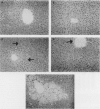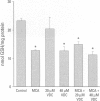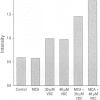Abstract
Vinylidene chloride (VDC) is a groundwater and drinking water contaminant. Monochloroacetic acid (MCA) is a chlorination by-product of drinking water. Because environmental or occupational exposure to chemicals takes place at low concentrations, a sensitive in vitro system of liver slices was used to examine the interactive toxicity of MCA and VDC. Liver slices from Sprague-Dawley rats were exposed to 100 microM MCA for 1 hr before exposure to 20 or 48 microM VDC and incubated for 1 to 8 hr. MCA + 48 microM VDC resulted in a significant leakage of K+ by 4 hr, while MCA+ 20 microM VDC did not. At 4 hr, MCA + 48 microM VDC resulted in centrilobular necrosis. MCA caused a significant depletion of slice glutathione (GSH) at 1 hr, which was maintained up to 3 hr. As reactive VDC metabolites are detoxified by conjugation with GSH, the increase in VDC toxicity by MCA is possibly due to GSH-depleting effects of MCA. Heat shock protein (HSP) 72 was increased 2.5-fold by MCA + 20 microM VDC as early as 2 hr, although K+ leakage was not increased. MCA + 48 microM VDC resulted in a 3-fold increase in HSP 72 by 2 hr, while there were modest increases in HSPs 60 and 32. Therefore, HSP 72 is an early sensitive indicator of interactive toxicity of nontoxic concentrations of MCA and VDC. This is the first time that micromolar concentrations of these drinking water contaminants were observed to affect cellular homeostasis in the liver.
Full text
PDF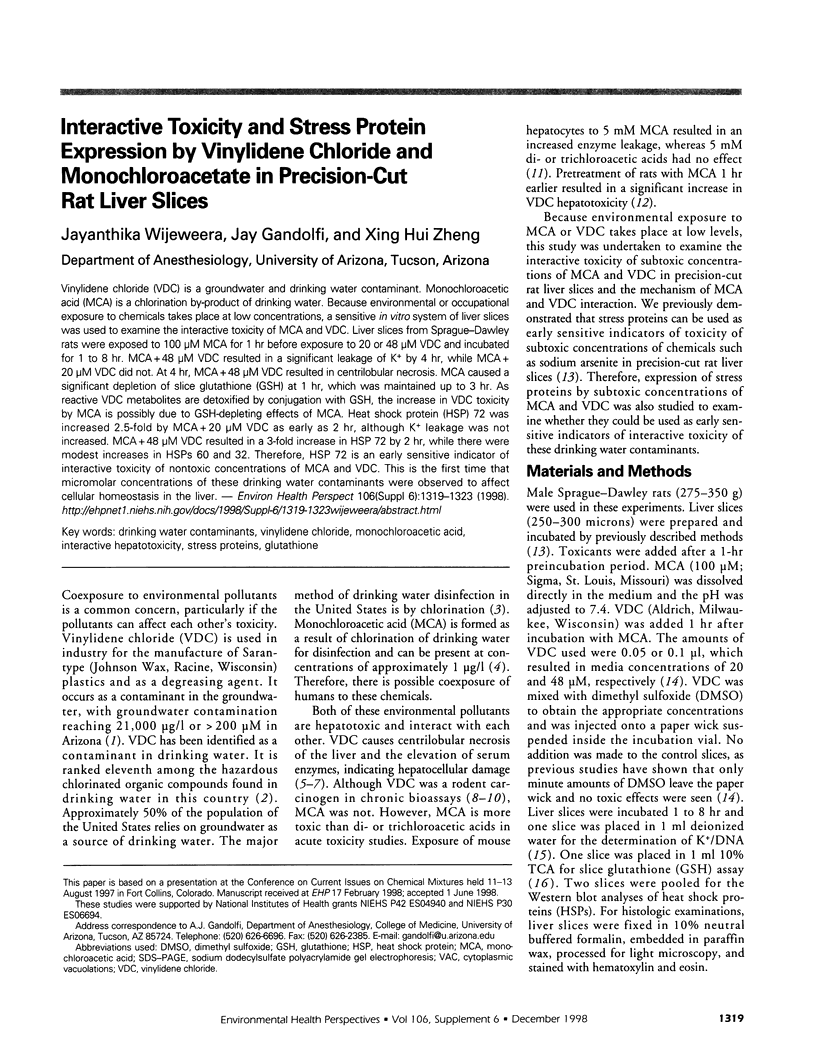
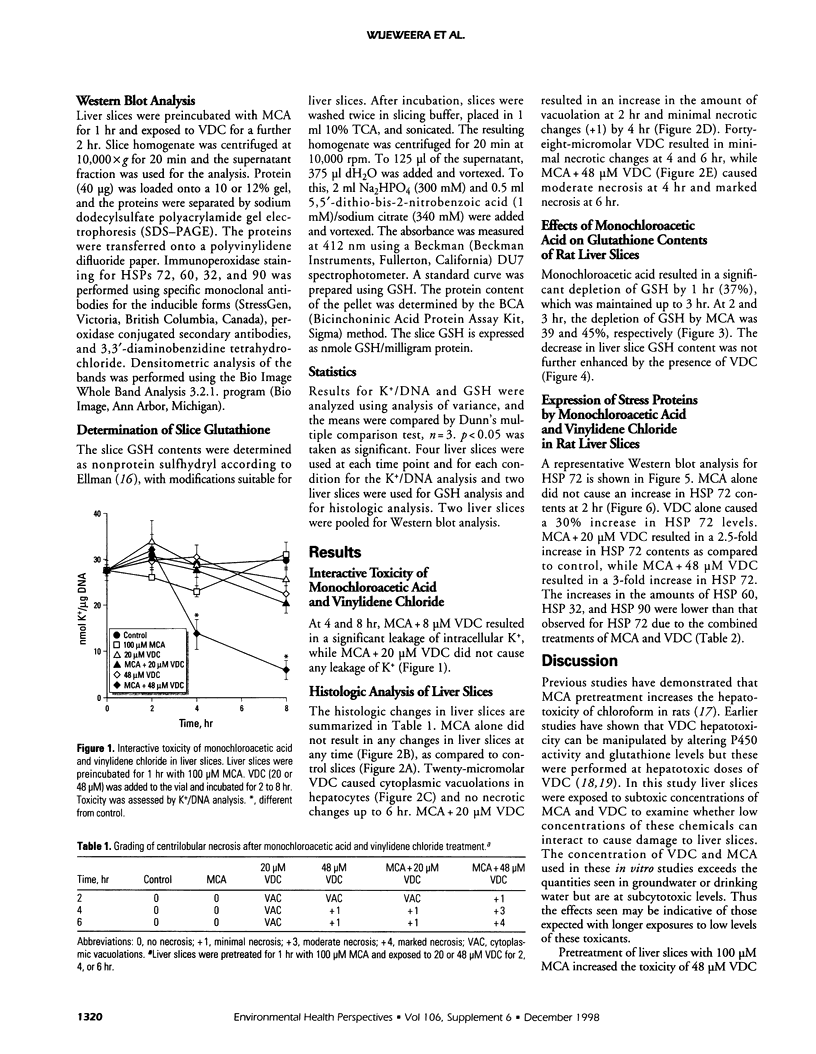

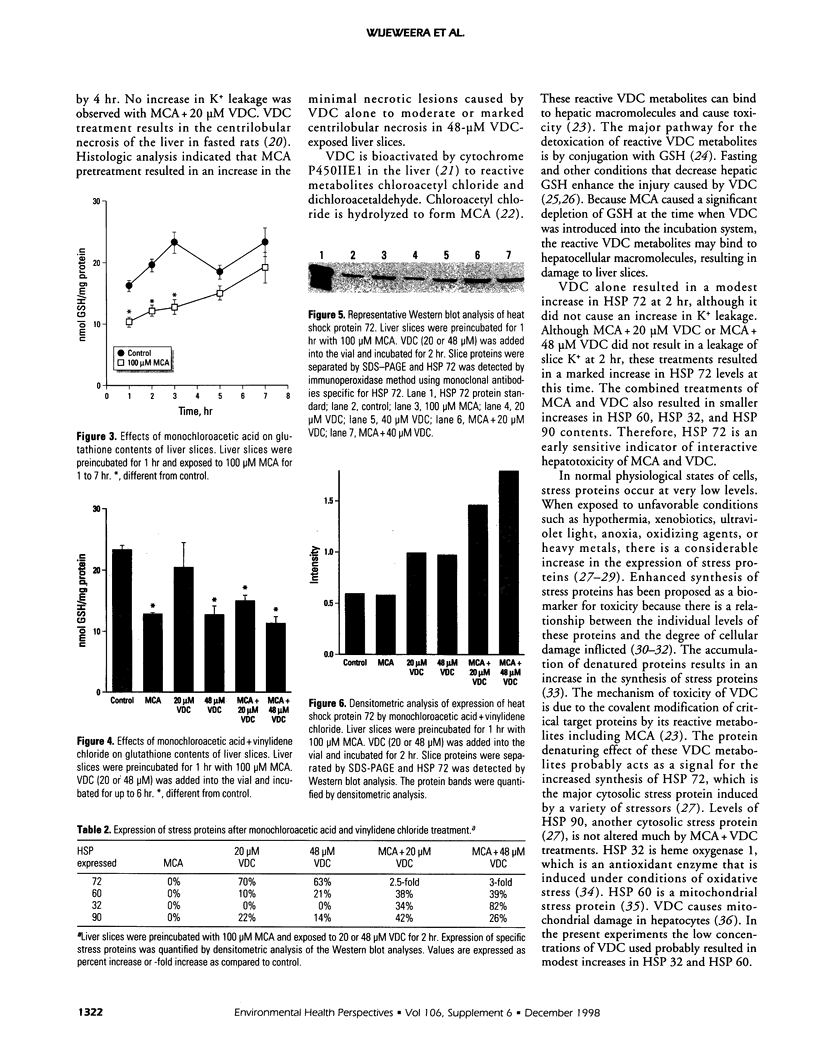
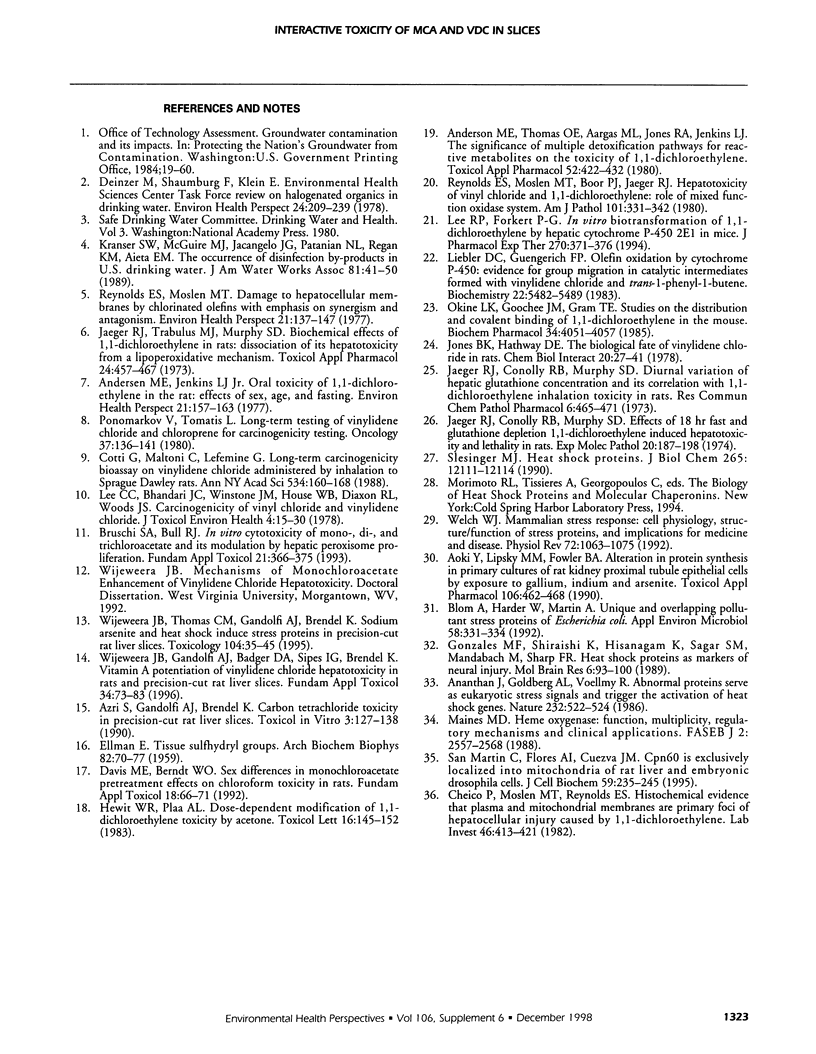
Images in this article
Selected References
These references are in PubMed. This may not be the complete list of references from this article.
- Ananthan J., Goldberg A. L., Voellmy R. Abnormal proteins serve as eukaryotic stress signals and trigger the activation of heat shock genes. Science. 1986 Apr 25;232(4749):522–524. doi: 10.1126/science.3083508. [DOI] [PubMed] [Google Scholar]
- Andersen M. E., Jenkins L. J., Jr Oral toxicity of 1,1-dichloroethylene in the rat: effects of sex, age, and fasting. Environ Health Perspect. 1977 Dec;21:157–163. doi: 10.1289/ehp.7721157. [DOI] [PMC free article] [PubMed] [Google Scholar]
- Andersen M. E., Thomas O. E., Gargas M. L., Jones R. A., Jenkins L. J., Jr The significance of multiple detoxification pathways for reactive metabolites in the toxicity of 1,1-dichloroethylene. Toxicol Appl Pharmacol. 1980 Mar 15;52(3):422–432. doi: 10.1016/0041-008x(80)90337-3. [DOI] [PubMed] [Google Scholar]
- Aoki Y., Lipsky M. M., Fowler B. A. Alteration in protein synthesis in primary cultures of rat kidney proximal tubule epithelial cells by exposure to gallium, indium, and arsenite. Toxicol Appl Pharmacol. 1990 Dec;106(3):462–468. doi: 10.1016/0041-008x(90)90341-q. [DOI] [PubMed] [Google Scholar]
- Blom A., Harder W., Matin A. Unique and overlapping pollutant stress proteins of Escherichia coli. Appl Environ Microbiol. 1992 Jan;58(1):331–334. doi: 10.1128/aem.58.1.331-334.1992. [DOI] [PMC free article] [PubMed] [Google Scholar]
- Bruschi S. A., Bull R. J. In vitro cytotoxicity of mono-, di-, and trichloroacetate and its modulation by hepatic peroxisome proliferation. Fundam Appl Toxicol. 1993 Oct;21(3):366–375. doi: 10.1006/faat.1993.1109. [DOI] [PubMed] [Google Scholar]
- Chieco P., Moslen M. T., Reynolds E. S. Histochemical evidence that plasma and mitochondrial membranes are primary foci of hepatocellular injury caused by 1,1-dichloroethylene. Lab Invest. 1982 Apr;46(4):413–421. [PubMed] [Google Scholar]
- Cotti G., Maltoni C., Lefemine G. Long-term carcinogenicity bioassay on vinylidene chloride administered by inhalation to Sprague-Dawley rats. New results. Ann N Y Acad Sci. 1988;534:160–168. doi: 10.1111/j.1749-6632.1988.tb30109.x. [DOI] [PubMed] [Google Scholar]
- Davis M. E., Berndt W. O. Sex differences in monochloroacetate pretreatment effects on chloroform toxicity in rats. Fundam Appl Toxicol. 1992 Jan;18(1):66–71. doi: 10.1016/0272-0590(92)90196-o. [DOI] [PubMed] [Google Scholar]
- Deinzer M., Schaumburg F., Klein E. Environmental health sciences center task force review on halogenated organics in drinking water. Environ Health Perspect. 1978 Jun;24:209–239. doi: 10.1289/ehp.7824209. [DOI] [PMC free article] [PubMed] [Google Scholar]
- ELLMAN G. L. Tissue sulfhydryl groups. Arch Biochem Biophys. 1959 May;82(1):70–77. doi: 10.1016/0003-9861(59)90090-6. [DOI] [PubMed] [Google Scholar]
- Gonzalez M. F., Shiraishi K., Hisanaga K., Sagar S. M., Mandabach M., Sharp F. R. Heat shock proteins as markers of neural injury. Brain Res Mol Brain Res. 1989 Jul;6(1):93–100. doi: 10.1016/0169-328x(89)90033-8. [DOI] [PubMed] [Google Scholar]
- Hewitt W. R., Plaa G. L. Dose-dependent modification of 1,1-dichloroethylene toxicity by acetone. Toxicol Lett. 1983 Apr;16(1-2):145–152. doi: 10.1016/0378-4274(83)90023-1. [DOI] [PubMed] [Google Scholar]
- Jaeger R. J., Conolly R. B., Murphy S. D. Diurnal variation of hepatic glutathione concentration and its correlation with 1,1-dichloroethylene inhalation toxicity in rats. Res Commun Chem Pathol Pharmacol. 1973 Sep;6(2):465–471. [PubMed] [Google Scholar]
- Jaeger R. J., Conolly R. B., Murphy S. D. Effect of 18 hr fast and glutathione depletion on 1,1-dichloroethylene-induced hepatotoxicity and lethality in rats. Exp Mol Pathol. 1974 Apr;20(2):187–198. doi: 10.1016/0014-4800(74)90053-7. [DOI] [PubMed] [Google Scholar]
- Jaeger R. J., Trabulus M. J., Murphy S. D. Biochemical effects of 1,1-dichloroethylene in rats: dissociation of its hepatotoxicity from a lipoperoxidative mechanism. Toxicol Appl Pharmacol. 1973 Mar;24(3):457–467. doi: 10.1016/0041-008x(73)90052-5. [DOI] [PubMed] [Google Scholar]
- Jones B. K., Hathway D. E. The biological fate of vinylidene chloride in rats. Chem Biol Interact. 1978 Jan;20(1):27–41. doi: 10.1016/0009-2797(78)90078-9. [DOI] [PubMed] [Google Scholar]
- Lee C. C., Bhandari J. C., Winston J. M., House W. B., Dixon R. L., Woods J. S. Carcinogenicity of vinyl chloride and vinylidene chloride. J Toxicol Environ Health. 1978 Jan;4(1):15–30. doi: 10.1080/15287397809529640. [DOI] [PubMed] [Google Scholar]
- Lee R. P., Forkert P. G. In vitro biotransformation of 1,1-dichloroethylene by hepatic cytochrome P-450 2E1 in mice. J Pharmacol Exp Ther. 1994 Jul;270(1):371–376. [PubMed] [Google Scholar]
- Liebler D. C., Guengerich F. P. Olefin oxidation by cytochrome P-450: evidence for group migration in catalytic intermediates formed with vinylidene chloride and trans-1-phenyl-1-butene. Biochemistry. 1983 Nov 22;22(24):5482–5489. doi: 10.1021/bi00293a005. [DOI] [PubMed] [Google Scholar]
- Maines M. D. Heme oxygenase: function, multiplicity, regulatory mechanisms, and clinical applications. FASEB J. 1988 Jul;2(10):2557–2568. [PubMed] [Google Scholar]
- Martin C. S., Flores A. I., Cuezva J. M. Cpn60 is exclusively localized into mitochondria of rat liver and embryonic Drosophila cells. J Cell Biochem. 1995 Oct;59(2):235–245. doi: 10.1002/jcb.240590212. [DOI] [PubMed] [Google Scholar]
- Okine L. K., Goochee J. M., Gram T. E. Studies on the distribution and covalent binding of 1,1-dichloroethylene in the mouse. Effect of various pretreatments on covalent binding in vivo. Biochem Pharmacol. 1985 Nov 15;34(22):4051–4057. doi: 10.1016/0006-2952(85)90386-7. [DOI] [PubMed] [Google Scholar]
- Ponomarkov V., Tomatis L. Long-term testing of vinylidene chloride and chloroprene for carcinogenicity in rats. Oncology. 1980;37(3):136–141. doi: 10.1159/000225422. [DOI] [PubMed] [Google Scholar]
- Reynolds E. S., Moslen M. T., Boor P. J., Jaeger R. J. 1,1-Dichloroethylene hepatotoxicity. Time course of GSH changes and biochemical aberrations. Am J Pathol. 1980 Nov;101(2):331–344. [PMC free article] [PubMed] [Google Scholar]
- Reynolds E. S., Moslen M. T. Damage to hepatic cellular membranes by chlorinated olefins with emphasis on synergism and antagonism. Environ Health Perspect. 1977 Dec;21:137–147. doi: 10.1289/ehp.7721137. [DOI] [PMC free article] [PubMed] [Google Scholar]
- Schlesinger M. J. Heat shock proteins. J Biol Chem. 1990 Jul 25;265(21):12111–12114. [PubMed] [Google Scholar]
- Welch W. J. Mammalian stress response: cell physiology, structure/function of stress proteins, and implications for medicine and disease. Physiol Rev. 1992 Oct;72(4):1063–1081. doi: 10.1152/physrev.1992.72.4.1063. [DOI] [PubMed] [Google Scholar]
- Wijeweera J. B., Thomas C. M., Gandolfi A. J., Brendel K. Sodium arsenite and heat shock induce stress proteins in precision-cut rat liver slices. Toxicology. 1995 Dec 15;104(1-3):35–45. doi: 10.1016/0300-483x(95)03119-z. [DOI] [PubMed] [Google Scholar]
- Wueweera J. B., Gandolfi A. J., Badger D. A., Sipes I. G., Brendel K. Vitamin A potentiation of vinylidene chloride hepatotoxicity in rats and precision-cut rat liver slices. Fundam Appl Toxicol. 1996 Nov;34(1):73–83. [PubMed] [Google Scholar]



